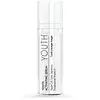What's inside
What's inside
 Key Ingredients
Key Ingredients

 Benefits
Benefits

 Concerns
Concerns

No concerns
 Ingredients Side-by-side
Ingredients Side-by-side

Water
Skin ConditioningDimethicone
EmollientGlycerin
HumectantPolysorbate 20
EmulsifyingPropanediol
SolventDipentaerythrityl Hexacaprylate/Hexacaprate
EmulsifyingHydroxypropyl Cyclodextrin
MaskingHydroxyethyl Acrylate/Sodium Acryloyldimethyl Taurate Copolymer
Emulsion StabilisingDimethicone/Vinyl Dimethicone Crosspolymer
Skin ConditioningLotus Japonicus Somatic Embryo Extract
AntioxidantMalus Domestica Fruit Cell Culture Extract
Skin ConditioningSchisandra Chinensis Fruit Extract
Skin ConditioningRetinol
Skin ConditioningVitis Rotundifolia Fruit Extract
Skin ConditioningCananga Odorata Flower Oil
MaskingSodium Hyaluronate
HumectantEnteromorpha Compressa Extract
Skin ProtectingTocopheryl Acetate
AntioxidantEugenia Caryophyllus Leaf Oil
MaskingPanthenol
Skin ConditioningCaesalpinia Spinosa Gum
Skin ConditioningAcacia Decurrens Extract
AstringentCoriandrum Sativum Fruit Oil
MaskingTocopherol
AntioxidantRetinyl Palmitate
Skin ConditioningMagnesium Ascorbyl Phosphate
AntioxidantVitis Vinifera Seed Extract
AntimicrobialBeta-Glucan
Skin ConditioningSuperoxide Dismutase
AntioxidantCaprylic/Capric Triglyceride
MaskingSqualane
EmollientLauroyl Lysine
Skin ConditioningPhenoxyethanol
PreservativeAcrylates/C10-30 Alkyl Acrylate Crosspolymer
Emulsion StabilisingEthylhexylglycerin
Skin ConditioningCaprylyl Glycol
EmollientPolysorbate 60
Emulsifying1,2-Hexanediol
Skin ConditioningLecithin
EmollientSodium Hydroxide
BufferingSodium Phytate
Sorbitan Isostearate
EmulsifyingXanthan Gum
EmulsifyingWater, Dimethicone, Glycerin, Polysorbate 20, Propanediol, Dipentaerythrityl Hexacaprylate/Hexacaprate, Hydroxypropyl Cyclodextrin, Hydroxyethyl Acrylate/Sodium Acryloyldimethyl Taurate Copolymer, Dimethicone/Vinyl Dimethicone Crosspolymer, Lotus Japonicus Somatic Embryo Extract, Malus Domestica Fruit Cell Culture Extract, Schisandra Chinensis Fruit Extract, Retinol, Vitis Rotundifolia Fruit Extract, Cananga Odorata Flower Oil, Sodium Hyaluronate, Enteromorpha Compressa Extract, Tocopheryl Acetate, Eugenia Caryophyllus Leaf Oil, Panthenol, Caesalpinia Spinosa Gum, Acacia Decurrens Extract, Coriandrum Sativum Fruit Oil, Tocopherol, Retinyl Palmitate, Magnesium Ascorbyl Phosphate, Vitis Vinifera Seed Extract, Beta-Glucan, Superoxide Dismutase, Caprylic/Capric Triglyceride, Squalane, Lauroyl Lysine, Phenoxyethanol, Acrylates/C10-30 Alkyl Acrylate Crosspolymer, Ethylhexylglycerin, Caprylyl Glycol, Polysorbate 60, 1,2-Hexanediol, Lecithin, Sodium Hydroxide, Sodium Phytate, Sorbitan Isostearate, Xanthan Gum
 Reviews
Reviews

Ingredients Explained
These ingredients are found in both products.
Ingredients higher up in an ingredient list are typically present in a larger amount.
1,2-Hexanediol is a synthetic liquid and another multi-functional powerhouse.
It is a:
- Humectant, drawing moisture into the skin
- Emollient, helping to soften skin
- Solvent, dispersing and stabilizing formulas
- Preservative booster, enhancing the antimicrobial activity of other preservatives
Panthenol is a common ingredient that helps hydrate and soothe the skin. It is found naturally in our skin and hair.
There are two forms of panthenol: D and L.
D-panthenol is also known as dexpanthenol. Most cosmetics use dexpanthenol or a mixture of D and L-panthenol.
Panthenol is famous due to its ability to go deeper into the skin's layers. Using this ingredient has numerous pros (and no cons):
Like hyaluronic acid, panthenol is a humectant. Humectants are able to bind and hold large amounts of water to keep skin hydrated.
This ingredient works well for wound healing. It works by increasing tissue in the wound and helps close open wounds.
Once oxidized, panthenol converts to pantothenic acid. Panthothenic acid is found in all living cells.
This ingredient is also referred to as pro-vitamin B5.
Learn more about PanthenolPhenoxyethanol is a preservative that has germicide, antimicrobial, and aromatic properties. Studies show that phenoxyethanol can prevent microbial growth. By itself, it has a scent that is similar to that of a rose.
It's often used in formulations along with Caprylyl Glycol to preserve the shelf life of products.
Sodium Hyaluronate is hyaluronic acid's salt form. It is commonly derived from the sodium salt of hyaluronic acid.
Like hyaluronic acid, it is great at holding water and acts as a humectant. This makes it a great skin hydrating ingredient.
Sodium Hyaluronate is naturally occurring in our bodies and is mostly found in eye fluid and joints.
These are some other common types of Hyaluronic Acid:
Learn more about Sodium Hyaluronate